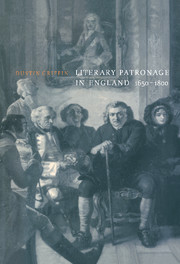Book contents
- Frontmatter
- Contents
- Acknowledgments
- 1 Introduction
- 2 The cultural economics of literary patronage
- 3 The politics of patronage
- 4 John Dryden
- 5 Jonathan Swift
- 6 Alexander Pope
- 7 Edward Young and Richard Savage
- 8 Mary Leapor and Charlotte Lennox
- 9 Samuel Johnson
- 10 The persistence of patronage
- 11 Conclusion
- Bibliography
- Index
8 - Mary Leapor and Charlotte Lennox
Published online by Cambridge University Press: 22 August 2009
- Frontmatter
- Contents
- Acknowledgments
- 1 Introduction
- 2 The cultural economics of literary patronage
- 3 The politics of patronage
- 4 John Dryden
- 5 Jonathan Swift
- 6 Alexander Pope
- 7 Edward Young and Richard Savage
- 8 Mary Leapor and Charlotte Lennox
- 9 Samuel Johnson
- 10 The persistence of patronage
- 11 Conclusion
- Bibliography
- Index
Summary
Recent attention has been directed at the efforts of professional playwrights like Aphra Behn and early novelists like Delariviere Manley to earn the rewards of authorship. Some attention has been paid as well to the peasant poets of the mid- and late-eighteenth century (such as Ann Yearsley) who were taken up by female patrons. But little work has been done on the role of women in the patronage system. Some women may have hesitated to enter into an arrangement whereby they implicitly engaged to exchange “benefits” with a patron – especially a male patron – or to accept his “protection” at a time when “protection” was a euphemism for sexual “keeping.” (This may have promoted the emergence of female patrons.) On the other hand, the traditional dependent status of women may have in fact made it easier for patrons to agree to protect them and for women writers to become literarily dependent upon a patron. But even if a patron chose to “protect” a female writer, there were fewer benefits he could confer upon her than upon a man: a woman in the eighteenth century would not be named private secretary to a peer, or set up as a political journalist, or appointed to a church living. Isobel Grundy notes that some of the functions of the patron – introductions, public endorsements, collecting subscriptions – were during the course of the century taken over by other writers.
- Type
- Chapter
- Information
- Literary Patronage in England, 1650–1800 , pp. 189 - 219Publisher: Cambridge University PressPrint publication year: 1996

